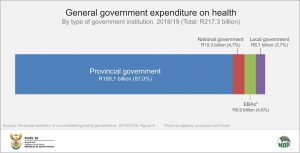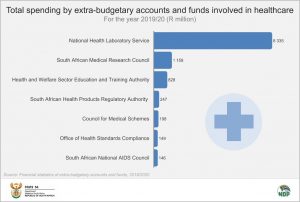The role of EBAs in public healthcare spending
There are a small number of healthcare institutions that fall in the extra-budgetary accounts and funds (EBAs) arm of government. You may have heard of the South African Medical Research Council and the South African Health Products Regulatory Authority in media coverage of COVID-19. A recent report by Stats SA provides pre-COVID-19 financial data for these two institutions, as well as for 253 other EBAs.
Gaining insight into the state of public healthcare spending before COVID-19 provides a benchmark for when pandemic-era data eventually become available. The South African public healthcare bill was R217 billion in 2018/19, according to Stats SA’s latest Financial statistics of consolidated general government report. This translates to 12,1% of total general government spending, making it the fourth biggest expenditure item after general public services, education and social protection.1
Provincial government accounted for the bulk (87%) of the R217 billion. This is expected, as provincial government is responsible for maintaining and administrating the nation’s public hospitals and clinics. National government accounted for 4,7%, and EBAs 4,6%.
Provincial government may be the dominant player in the public healthcare space, but there are smaller players too. The South African government website lists almost 80 institutions (if we exclude government departments, hospitals and clinics) that are involved in public healthcare.2 These smaller institutions include associations, societies, councils, foundations and universities.
Stats SA’s most recent Financial statistics of extra-budgetary accounts and funds report provides financial detail on EBAs that are active in this space. EBAs play an important role in delivering services to government or to the public on behalf of government.3
As mentioned above, EBAs account for almost 5% of public healthcare spending. In 2018/19, this totalled R9,9 billion, rising to R11,1 billion in 2019/20. Seven EBAs are involved in healthcare. The National Health Laboratory Service accounted for R8,3 billion (75%) of the R11,1 billion in 2019/20, followed by the South African Medical Research Council (SAMRC) and the Health and Welfare Sector Education and Training Authority.
Two of the seven institutions in particular have been in the news lately for contributing to the fight against the pandemic. The South African Health Products Regulatory Authority is at the forefront, responsible for the approval of COVID-19 vaccines. The SAMRC is known for its weekly reports on excess deaths, having tracked the first, second and third waves of the pandemic.4
An international perspective
The World Health Organisation (WHO) ranks South Africa in 49th place in terms of how much government spends on public healthcare as a percentage of total government spending. The health body’s latest figure for South Africa is 13,3% (for 2018), placing it in the company of countries such as Italy (13,2%), Lebanon (13,3%), Finland (13,3%), Portugal (13,4%) and Tunisia (13,6%).5
The top four countries on the WHO list that spend the most on public health as a proportion of total government spending are Costa Rica (27,8%), Japan (23,6%), San Marino (23,4%) and the USA (22,5%). Member countries of the OECD recorded an average of 18,1%.5
The full financial impact of the pandemic on the South African public health sector, in particular on specific institutions, is still to be determined. Stats SA will continue to report on the financial status of functions across government, including public health, and will provide an update when the data become available.
For more information, download the Financial statistics of extra-budgetary accounts and funds 2019/2020 report here.
1 Stats SA, Financial statistics of consolidated general government, 2018/2019. Table C and Figure 6 (download here).
2 South African Government, Health (available here).
3 EBAs mainly rely on government funding, either via financial transfers from national and provincial government or from sales of goods and services to other government institutions. Examples of EBAs include the South African Revenue Service, the Road Accident Fund and the South African National Roads Agency (SANRAL). The release contains data for all reporting EBAs within the framework of the Government Finance Statistics Manual, 2014 (GFSM 2014).
4 SAMRC, Report on weekly deaths in South Africa (available here).
5 World Health Organisation data via the World Bank Open Data portal, Domestic general government health expenditure (% of general government expenditure) (available here).



